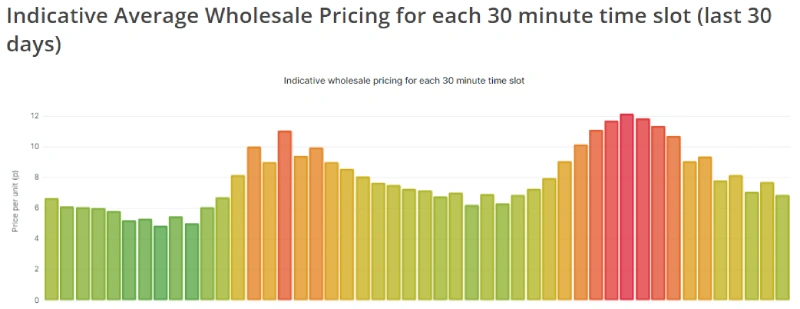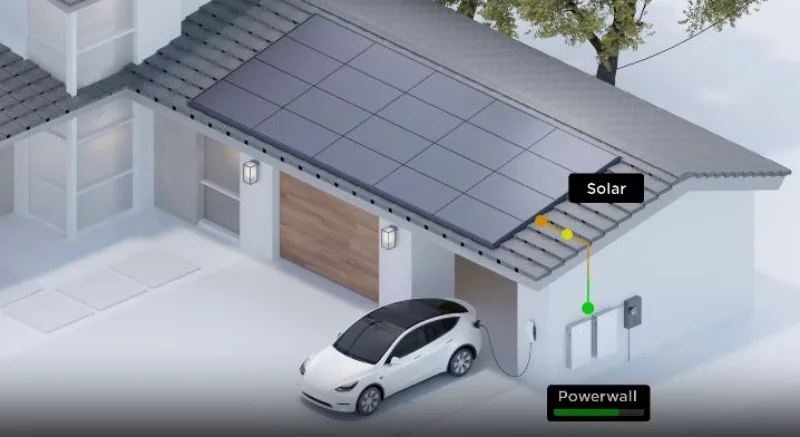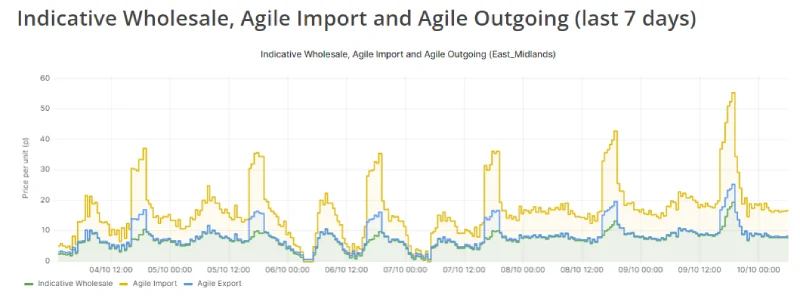Reducing peak demand charges with solar energy
In this article, we’ll explain in straightforward terms what ‘peak demand charges’ are and how to avoid them using your own solar panels and solar batteries in the UK.
Let’s go!
Contents List
- What are peak demand charges?
- What is having your own solar energy?
- How to reduce peak time charges with solar energy?
- Summary
What are peak demand charges?

Peak demand charges are the expensive electricity prices you pay during “peak” times when everyone uses electricity simultaneously.
Take the early morning between 6 am and 9 am as an example. Most people prepare for a day’s work at this time, turning on lights and appliances like electric stoves, coffee machines, electric heaters, etc.
This predictable surge in electricity demand during these “peak” times gives rise to the “peak demand charges” because the UK has a fixed number of power generators. A surge in demand over a steady supply equals expensive electricity!
💡 Peak demand charges don’t affect households and businesses on single-rate tariffs —i.e., those paying a consistent rate regardless of the time of day. They apply only to those on variable tariffs, such as Economy 7 or Octopus’ Agile Tariff.
💡 Peak demand charges are specific to electricity tariffs and not gas tariffs. Unlike electricity, excess natural gas can be easily stored, and gas consumption patterns don’t vary as wildly as electricity.
Extended Reading:
- Why is electricity cheaper at night?
- A guide to electricity tariffs
- Who is my gas and/or electricity supplier?
What is having your own solar energy?
Solar panels installed on residential rooftops in the Netherlands.While a significant portion of solar power in the UK is generated by large utility companies, an increasing amount is being generated and stored by ordinary homes and businesses through solar panels, solar batteries and thermal solar collectors:
- Solar panels: ‘Photovoltaic’ panels that turn incoming solar radiation into valuable electricity.
- Solar batteries: Chemical batteries are designed to store electricity generated by solar panels.
- Thermal solar collectors: ‘Water panels’ that capture the Sun’s heat to warm up water without the need for gas or electricity.
This trend has been growing due to the decreasing cost of solar panels and batteries, the UK’s legally binding climate commitments, and expensive electricity amidst the ongoing energy crisis.
💡 Other benefits include achieving ‘energy independence’, off-grid living, and even realising a profit by intelligently configuring your solar panels and solar batteries (this is also known as electricity arbitrage).
Extended Reading:
- Electricity Arbitrage: Turning a profit from your solar panels and battery
- Will Perovskite solar panels spark a solar revolution?
- Solaris Prism: Solar water heating made in Scotland
- Commercial solar panel costs
How to reduce peak time charges with solar energy?
It’s time to tackle the central question: How can anyone possibly use their own solar panels and batteries to reduce those hefty ‘peak demand charges’?
The key lies in understanding that these solar power systems come equipped with an EMS (Energy Management System) that allows the user to configure the flow of the generated solar power.
So, by configuring your system to cover the following scenarios, you will be automatically reducing (or even profiting from) peak time charges:
Consume your own solar power during peak times
Solar panels generate electricity from sunrise to sunset. The amount they produce is proportional to the Sun’s position, your panel’s orientation and weather conditions.
On the other hand, “peak demand charges” apply during peak times that tend to have some overlap with the panel’s generation, particularly during the summer months.
By configuring your panels to supply electricity directly to your appliances during these pricier peak times, you will effectively consume less electricity and pay less ‘peak demand charges’.
On a clear yet cool summer’s day, bringing your peak demand charges to zero is technically possible, but this would require a lot of excess solar panels. Incorporating a battery system is much more effective.
Use stored solar power during peak times

There are two issues why solar panels alone are rarely enough to reduce ‘peak demand charges sufficiently’:
- Peak price times don’t coincide with peak solar power generation.
- Solar power is intermittent; its output varies based on the season and weather conditions.
Enter solar batteries, enabling users to store excess electricity generated during peak solar hours for use during times of expensive electricity.
The challenge shifts to programming the system to move electricity around like clockwork– considering that each property has a unique solar system and electricity usage patterns.
Once this is overcome, you could forever be waving goodbye to ‘peak demand charges’ altogether.
💡 Off-grid properties –i.e. those who unplug grid connection– enjoy complete independence from these costs altogether. This autonomy may even be more beneficial than having the capacity to sell your excess by removing the burden of hefty standing charges. Use our energy price cap checker to see these for yourself!
Signing up to a Smart Export Guarantee (SEG) tariff

This next layer transcends merely reducing your ‘peak demand charges’ to almost zero but takes advantage of the reverse as you become the generator.
On days when you have enough power to meet your peak time consumption and have stored enough to make sure you meet the next, you can start selling your excess electricity back to the national grid through the smart export guarantee and generate a profit.
These ‘peak demand charges’ work both ways: it makes electricity expensive to buy but profitable to sell (although naturally, not quite at the same rate…).
💡 Remember that your export rates may vary dramatically depending on your export tariff, a ‘fixed’ tariff whose price doesn’t budge to a ‘variable’ tariff whose price changes every half an hour in response to the wholesale electricity markets.
Signing up for Demand Flexibility Services
Finally, the last straw to reducing your ‘peak demand charges’ is to sign up for Demand Flexibility Services, which pays consumers in exceptional circumstances for reducing their consumption during peak times.
This means you can get paid a premium for doing what you already do: Avoiding peak demand charges!
💡The Demand Flexibility Service is one of several tools local electricity distribution networks use to reduce electricity demand when it expects to struggle to meet it. For example, a windless and cold evening where UK wind farms will not generate their expected capacity.
Summary
Essentially, a solar system (yes, it’s named just like our intergalactic home) can help any business or household reduce or downright eliminate the infamous ‘peak demand charges’.
This can be done under any installation complexity, from a DIY installation of old solar panels, all the way to having the entire stack of solar roof tiles + batteries + solar thermal collectors (which can also trim your gas bill!).
Honestly, this is only the tip of the self-generation iceberg: the benefits of having your own clean energy independence are too plentiful for a short article!
Extended Reading:
- 8 reasons why you should get a home battery system
- Are solar panels going to cause a utilities death spiral?
- Solar-powered seawater greenhouses
- Electricity Bill Calculator for UK Homes
Peak demand charges in business energy
Peak demand charges are arguably a bigger issue in large business energy supplies.
Commercial properties with high electricity consumption are fitted with a half-hourly meter that measures the maximum demand of the property in any 30-minute period. If a business exceeds its agreed power capacity, it will be charged a maximum demand fee by its business energy supplier.
Businesses can follow the advice above to use commercial solar panels and batteries to minimise periods of peak demand to save on business electricity rates.